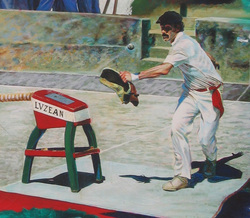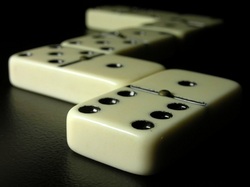Games in History
Games have been a part of civilization way back since ancient times. Throughout history popular games have changed and new games have been developed. Let us go back about 500 years. During these times life was very hard for children and most of them did not go to school. from an early age children had to help their families by working. In the midst of this tough lifestyle children had some time to relax and enjoy themselves by playing games.
Math: dice, sodoku
Spaldine hand ball alphabet game
War
Dodge ball
hide and seek
May I
Red light, Green light 1,2,3
Math: dice, sodoku
Spaldine hand ball alphabet game
War
Dodge ball
hide and seek
May I
Red light, Green light 1,2,3
Hand Ball

Handball is a sport in which players hit a small rubber ball against one or more walls using their hands. Handball has been played in the United States since the 1880s when Gaelic handball was brought to the country by Irish immigrants. A version of handball was played by the Aztecs as the Mesoamerican ballgame. The game is played in a four-wall rectangular shaped court and may be played as singles or doubles.
Stoop Ball

Stoop ball is a game that is played by throwing balls against a stoop (stairs leading up to a building.) This game first became popular after World War II. Historically, stoop ball has been popular in Brooklyn and other inner cities. Stoop ball is a pickup neighborhood game played on the stairs of a residential dwelling by a minimum of two players. The rules are based loosely on baseball. The object of the game is to score the most runs in 9 innings. In the game, on player is the "batter" and the other players are the "fielders". The batter stands directly in front of the stairs and the fielders stand behind the batter across the sidewalk. The batter throws a pink rubber ball called a "spaldeen" at the stoop which bounces back towards the fielders. The objective of the game is to hit the ball so that it bounces back as far as possible. The number of bases registered by a hit is determined by the distance traveled by the ball before it is fielded, unless the ball is caught on the fly resulting in an out.
Dominoes

Each domino is a rectangular tile with a line dividing its face into two square ends. Each end is marked with a number of spots. To play the game 28 dominoes are needed. The dominoes are all placed facedown on a table and shuffled. Both opponents take seven dominoes and the player with the highest double begins. As the game continues, the players take turns laying down a domino with a like value to one previously placed down. If a player doesn't have a piece corresponding to the ones on the layout, they must pick from the pile. The first person to run out of dominoes wins. Domino pieces were historically carved from ivory or animal bone with small, round pips of inset ebony. The game's name comes from the pieces' resemblance to Venetian Carnival masks known as domini, which were white with black spots. The oldest domino sets have been dated from around 1350 B.C.E. Domino games have been played by kings and presidents. The oldest known domino set was found in Tutankhamen's tomb, among the ruins of Thebes. Tutankhamen was king of ancient Egypt in the 18th dynasty, 1355 BC.
Potsey (Hopscotch)

Hopscotch is a popular children's playground game. To play this game a course is laid on the ground, usually drawn with chalk on pavement. The first player tosses the marker into the first square. The player must then hop the course, skipping the square with the marker in it. Single squares must be hopped on one foot. The player must then turn around and return through the course on one or two legs depending on the square until he or she reaches the square with their marker. They then must retrieve their marker and continue the course as stated without touching a line or stepping into a square with another player's marker.
Children in Ancient Egypt
Toys popular with children in Ancient Egypt include; dolls, toy soldiers, wooden animals, marbles, spinning tops and knucklebones. Instead of going to school most children in Egypt learned how to do tasks that would be useful for their future. The boys learned how to farm from their fathers and the girls did house chores such as cleaning and sewing. Boys that came from wealthy families learned reading, writing, and mathematics.
Children in Ancient Greece
Physical education in Greece was very important and a vital part of the children's lifestyle so boys did dancing and athletics. Discipline was severe in Greece and children were often beaten. In Sparta children were treated very harshly. At the age of 7 boys were removed from their families and sent to live in barracks. They were treated severely to turn them into brave soldiers. They were deliberately kept short of food so they would have to steal, which taught them stealth and cunning. Girls in Sparta learned athletics and dancing, keeping them healthy and able to produce more males that would eventually become soldiers. Children in Ancient Greece played ball games with inflated pig's bladders. They also played with spinning tops, dolls, model horses with wheels, hoops and rocking horses.
Children in Ancient Rome
Many people living in Rome were slaves and the children of slaves were automatically slaves. Roman children played with wooden or clay dolls and hoops. They also played ball games and board games. They also played with toy carts and with animal knucklebones.
Children in the Middle Ages
Childhood ended early for children in the Middle Ages. In upper class families girls married as young as 12 and boys as young as 14. They did not normally choose their own marriage partners. Their parents arranged their marriages for them. Children from poor families might have more choice about who they married but by the time they were about 7 or 8 they had to start helping their parents by doing simple jobs such as chasing away birds when crops had been sown or helping to weave wool. Children were expected to help the family earn a living as soon as they were able.
Aztec children were treated very harshly. If they misbehaved they could have cactus spines pushed into their skin or they were held over a fire containing chillies and were forced to inhale the smoke. However the Aztecs believed education was important. Boys learned jobs like farming and fishing from their fathers and girls learned skills like cooking and weaving from their mothers. However both boys and girls attended schools. (Although they were taught separately). The ordinary Aztec children went to a school called a telpochalli. They learned about history and religion but also about music and dance. When they were older boys learned to fight.
Aztec children were treated very harshly. If they misbehaved they could have cactus spines pushed into their skin or they were held over a fire containing chillies and were forced to inhale the smoke. However the Aztecs believed education was important. Boys learned jobs like farming and fishing from their fathers and girls learned skills like cooking and weaving from their mothers. However both boys and girls attended schools. (Although they were taught separately). The ordinary Aztec children went to a school called a telpochalli. They learned about history and religion but also about music and dance. When they were older boys learned to fight.
